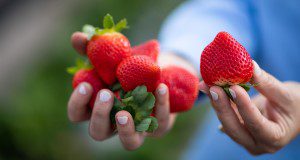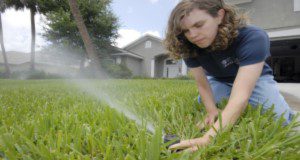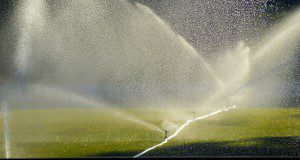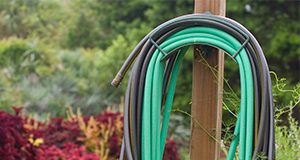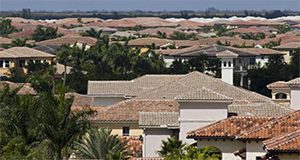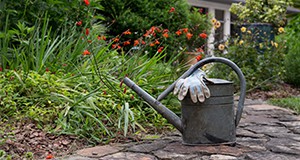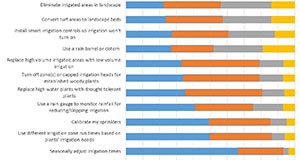Florida es el segundo productor de fresa más grade de los Estados Unidos, con un valor estimado de $337 millones. La siembra inicia entre finales de septiembre y mediados de octubre, en momentos donde las altas temperaturas representan un reto significativo para la sobrevivencia de los trasplantes, y por tanto también para el rendimiento y la calidad. El propósito principal de esta publicación es proporcionar recomendaciones basadas en resultados de investigación sobre métodos de establecimientos de trasplantes para productores de fresas en la Florida.
This new 5-page publication of the UF/IFAS Horticultural Sciences Department is the Spanish translation of HS1376, Methods for Strawberry Transplant Establishment in Florida. Written by Emmanuel Torres-Quezada, Lincoln Zotarelli, Vance M. Whitaker, and Shinsuke Agehara.
https://edis.ifas.ufl.edu/hs1378
Tag: Water Conservation
Considering Participants’ Personal Wellness in Conservation-Based Extension Programs: Opportunities for Integrative Development and Evaluation
Extension organizations are at the forefront of water resource issues, using educational programs to drive participant behaviors towards water conservation. The effectiveness of these efforts centers on designing programs with considerations of the factors that will change relevant decisions and behaviors among residential landscape water users. We conducted a statewide study to explore the concept of wellness and well-being, and these characteristics’ relationship to water conservation behaviors. Our results show that psychosocial measures influence current and future residential landscape water conservation behaviors differently. Perception of well-being is the more consistent predictor for both current behaviors and future intentions. These results demonstrate an opportunity for those focused on environmental behaviors to pair and embed programs focused on personal well-being to empower communities to work toward achieving conservation goals.
https://edis.ifas.ufl.edu/wc370
Best Practices for Communicating about Outdoor Residential Water Conservation
Extension communication efforts can be made more effective when following a strategic communication plan. To guide a strategic communication effort, it is imperative to have purposeful messaging along with an understanding of your target audience and communication channel. This new 3-page document, published by the UF/IFAS Department of Agricultural Education and Communication, presents a synthesis of literature highlighting best communication practices in regard to water conservation efforts. Written by Jacqueline Aenlle and Laura A. Sanagorski Warner.
https://edis.ifas.ufl.edu/wc366
Floridians' Engagement in Landscape Best Practices to Protect Water Resources: Information from a 2018 Survey
Extension programs are most effective when informed by a deep understanding of the target audience. To guide programs in Florida’s managed landscapes, especially pertaining to water quality and conservation, faculty from the UF/IFAS Center for Landscape Conservation and Ecology conduct an annual statewide survey. The survey gathers data that includes common landscape elements, neighborhood characteristics, engagement in irrigation and fertilizer best practices, and learning preferences. This new 5-page publication of the UF/IFAS Department of Agricultural Education and Communication presents highlights from the 2018 statewide survey with recommendations for how to use the information. Written by Laura A. Warner, Esen Momol, Claire Lewis, Tom Wichman, Wendy Wilber, and A. J. Reisinger.
https://edis.ifas.ufl.edu/wc345
Exploring Relationships among Social Norms, Aesthetics, HOA Regulations and Water Conservation
In the United States, landscape irrigation often consumes 50% or more of residential water used, and aesthetics may take preference over water-conserving elements in the landscape. Other factors such as perceived social norms and homeowners' association (HOA) regulations also impact water conservation behaviors. Binary logistic regression estimated the impact of aesthetics, perceived social norms, and HOA regulations on water conservation intentions. Findings revealed that when individuals placed a higher-than-average value on aesthetics and perceived stronger social support for conservation, home irrigation users had greater intent to conserve water. This new 4-page publication of the UF/IFAS Department of Agricultural Education and Communication was written by Amanda D. Ali and Laura A. Sanagorski Warner.
http://edis.ifas.ufl.edu/wc331
Meeting US Nursery and Greenhouse Growers’ Needs with Water Conservation Extension Programs
This 5-page document presents results of a study designed to understand the knowledge level, adoption rate, and levels of continuance associated with eight water conservation technologies among nursery and greenhouse growers. Written by Laura A. Sanagorski Warner, Alexa J. Lamm, Sarah A. White, Paul R. Fisher, and Peyton N. Beattie and published by the UF/IFAS Department of Agricultural Education and Communication, January 2019.
http://edis.ifas.ufl.edu/wc327
Estimating Benefits of Residential Outdoor Water Conservation: A Step-by-Step Guide
This 9-page fact sheet written by Tatiana Borisova, Laura A. Warner, Jennison Searcy, Anil Kumar Chaudhary, and Michael Dukes and published by the UF Department of Food and Resource Economics in February 2017 was developed to help Extension agents, water-conservation managers, and homeowners estimate the economic benefits of residential outdoor water conservation. It provides guidance for reporting benefits, including lowered utility bills for homeowners, reduced water-delivery costs for utilities, and increased water supply. This publication also offers an example of an impact statement.
http://edis.ifas.ufl.edu/fe1009
Household Water Usage and Irrigation Practices
Water pollution and drought in the United States have made water scarcity a widespread concern. Currently, residential consumers account for most urban water use, and meaningful programs that lead to water conservation rely on a comprehensive understanding of how consumers use water inside and outside their homes. This 5-page fact sheet written by Hayk Khachatryan, Alicia Rihn, and Michael Dukes and published by the Department of Food and Resource Economics outlines University of Florida researchers’ assessments of current US household indoor and outdoor water use to assist policy makers and researchers with creating incentives for homeowners to conserve water.
http://edis.ifas.ufl.edu/fe996
Engaging High Water Users in Water Conservation #1: High Water Users' Experiences and Perceptions of Water
Florida has an abundance of water, but still faces an increased pressure on water resources because of a growing population, prosperous tourism, and an active agricultural industry. This five-page fact sheet is the first in a series discussing how Extension can improve high water users' engagement in water conservation by focusing on high water users' characteristics, experiences with water issues, and perceptions of water. Written by Pei-wen Huang and Alexa J. Lamm and published by the Department of Agricultural Education and Communication.
http://edis.ifas.ufl.edu/wc255
Using the Decision-Ade(TM) Segmentation Strategy to Better Understand Extension Audiences

Decision-Ade™ is a tool Extension can use to better understand how residents with a range of household budgets feel about their utility bills. Analyzing households in terms of both income and utility bill “botheredness” creates a more comprehensive picture of that household’s utility use and its willingness to modify utility consumption relative to other households. This 5-page fact sheet uses survey data of Florida residents to demonstrate the insights Decision Ade™ can provide and how those insights can inform Extension programming. Written by Randall Cantrell, Laura Warner, Joy Rumble, and Alexa Lamm, and published by the UF Department of Family, Youth and Community Sciences, July 2015.
http://edis.ifas.ufl.edu/fy1461
Encouraging Landscape Water-Conservation Behaviors #1: Tailoring Programs To Florida Residents Who Use Irrigation in the Home Landscape
To better promote water-conservation practices among homeowners who irrigate their landscaping, Extension professionals must first have a clear understanding of this target audience’s habits, beliefs, and needs. This 10-page fact sheet recommends that Extension professionals analyze their audiences through several factors, including their interest in water conservation and knowledge of water issues and laws. Written by Laura A. Warner, Emmett Martin, Alexa Lamm, Joy Rumble, and Randall Cantrell, and published by the UF Department of Agricultural Education and Communication, May 2015. http://edis.ifas.ufl.edu/wc199
Engaging Consumers in At-Home Water Conservation: A Guide for Extension
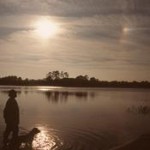 With a growing urban population and increased demands on water for recreational and agricultural purposes, Florida will have to identify a solution to its water quality and quantity issues. Although all Florida residents will play a part in conserving water in the future, the ability of Extension faculty to work with consumers and encourage new water conservation behaviors at home will be vital. This 4-page fact sheet provides information to Extension faculty about the water conservation behaviors in which Florida residents currently engage, water conservation product ownership, and public interest in water-related topics. Written by Caroline G. Roper and Alexa J. Lamm, and published by the UF Department of Agricultural Education and Communication, September 2014.
With a growing urban population and increased demands on water for recreational and agricultural purposes, Florida will have to identify a solution to its water quality and quantity issues. Although all Florida residents will play a part in conserving water in the future, the ability of Extension faculty to work with consumers and encourage new water conservation behaviors at home will be vital. This 4-page fact sheet provides information to Extension faculty about the water conservation behaviors in which Florida residents currently engage, water conservation product ownership, and public interest in water-related topics. Written by Caroline G. Roper and Alexa J. Lamm, and published by the UF Department of Agricultural Education and Communication, September 2014.
http://edis.ifas.ufl.edu/wc169
Extension and the Environment: Understanding Florida Residents' Perceptions of Environmental Water-Related Topics
 By understanding Florida residents’ perceptions of water quality and quantity issues, Extension faculty can better communicate with them about water quantity and quality issues. This 4-page fact sheet explores Florida residents’ perceptions of water topics related to environmental issues. Written by Caroline G. Roper and Alexa J. Lamm, and published by the UF Department of Agricultural Education and Communication, September 2014.
By understanding Florida residents’ perceptions of water quality and quantity issues, Extension faculty can better communicate with them about water quantity and quality issues. This 4-page fact sheet explores Florida residents’ perceptions of water topics related to environmental issues. Written by Caroline G. Roper and Alexa J. Lamm, and published by the UF Department of Agricultural Education and Communication, September 2014.
http://edis.ifas.ufl.edu/wc167
AE453 Gray Water Reuse in Florida
AE453, a 5-page illustrated fact sheet by Christopher J. Martinez, provides an overview of the recycling of gray water, the ways that gray water can potentially be used, and the regulations and guidelines for gray water reuse in Florida, as well as discussion of some of the potential barriers to gray water reuse in Florida and elsewhere. Includes references. Published by the UF Department of Agricultural and Biological Engineering, January 2010.
http://edis.ifas.ufl.edu/ae453
FE756 Conservation Pricing for Residential Water Supply
FE756, a 7-page fact sheet by Tatiana Borisova, Burcin Unel, and Colin Rawls, defines the criteria used to design and evaluate conservation-based rates, considers alternative rate structures, and briefly discusses challenges posed by conservation-oriented rates for utility companies. Includes references. Published by the UF Department of Food and Resource Economics, November 2008.
http://edis.ifas.ufl.edu/FE756
